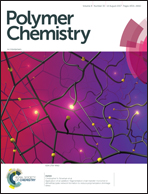Application of an addition–fragmentation-chain transfer monomer in di(meth)acrylate network formation to reduce polymerization shrinkage stress†
Abstract
A new addition–fragmentation chain transfer (AFT) capable moiety was incorporated into a dimethacrylate monomer that participated readily in network formation by copolymerizing with multifunctional methacrylates or acrylates. The process of AFT occurred simultaneously with photopolymerization of the AFT monomer (AFM) and other (meth)acrylate monomers leading to polymer stress relaxation via network reconfiguration. At low loading levels of the AFM, a significant reduction in shrinkage stress, especially for acrylate monomers, was observed with nominal effects on conversion. At higher loading levels of the AFM, the photopolymerization reaction kinetics and final double bond conversion were significantly lowered along with a delay in the gel-point conversion. Electron paramagnetic resonance studies during polymerization revealed the presence of a distinct radical species that was present in proportional quantities to the AFM content in the system. The lifetime and the character of the persistent radicals were altered due to the presence of the distinctive radical, in turn affecting the polymerization kinetics. With polymerization conducted at higher irradiance, the differential conversion between the control resin and samples with moderate AFM content was minimal, especially for the methacrylate-based formulations.



 Please wait while we load your content...
Please wait while we load your content...